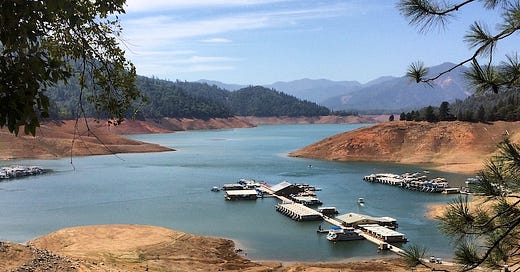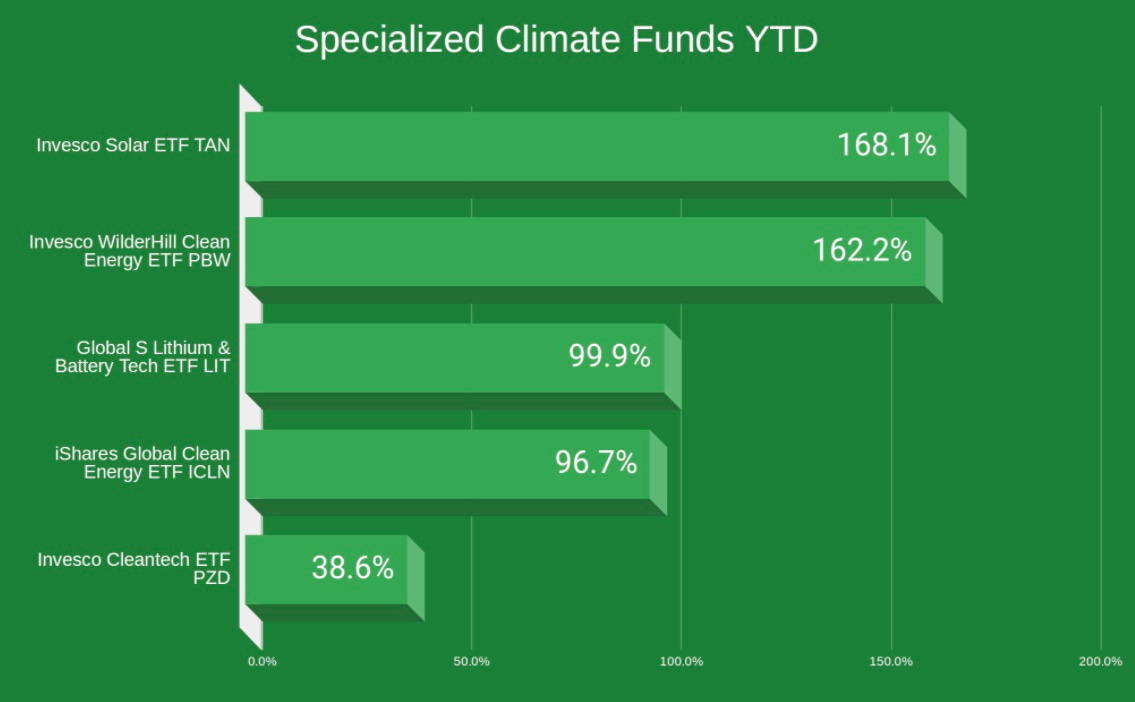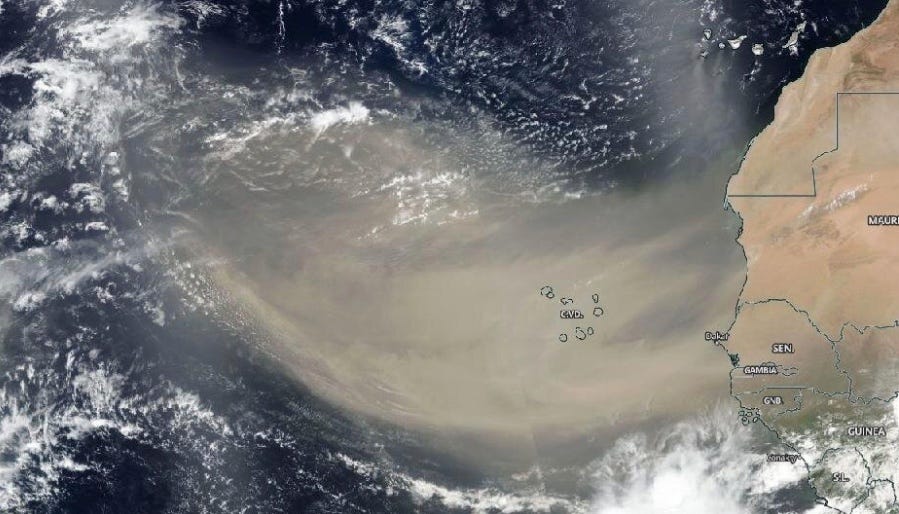The future(s) of water trading; top climate funds, and raise a beer to fight global warming
Plus, $100 trillion in carbon investing, Hannon Armstrong's Morgan Stanley deal, and clean energy defections at Shell

Here in California, water is as hot a topic as wildfires or Covid. A five-year drought a decade ago created the conditions for wildfires today, and lack of rain this year is threatening more fires as late as Christmas.
Next week, investors will be able to trade our water risk as the CME (Chicago Mercantile Exchange) begins offering water futures, the first U.S. derivatives contracts tied to the life-sustaining resource. The futures are based on the Nasdaq Veles California Water Index (NQH2O), which began trading two years ago and which has doubled year-to-date. See a chart of the index here.
California uses more than four times the water as any other state, mostly for agriculture. But its susceptibility to droughts, like the one we’re seeing right now, make the transparency of a water price quite valuable to farmers and investors alike. Similar water-trading products have been launched in Southern Africa and Australia, though not without controversy. And there are a host of water-related ETFs.
As with any scarce resource, the possibility to trade it becomes attractive. But given that wars have been fought over water rights, I expect a backlash to the commodification of something so valuable. Next week’s futures launch kicks off a new era for something we’ve always regarded as free.
The story of pricing water is just beginning.
More insights below. . . .
Don’t forget to contact me directly if you have suggestions or ideas at dcallaway@callawayclimateinsights.com.
Survey: We’d like your view on things

. . . . The growth of subscribers to Callaway Climate Insights has been strong this year, and anecdotally we’ve received a number of compliments for our coverage, from investing, policy and politics, to stunning climate data and quirky animal stories. As we prepare to go daily and turn this into a real business in the new year, we’d like to hear your thoughts on what you like best. Please take two minutes and fill out this short survey. We appreciate it. . . .
Cheers. — David Callaway
. . . . Between $100 trillion and $150 trillion in new climate investing will be required before 2050 for the world to transition to a low-carbon economy in accordance with the Paris Agreement, according to a new report by the Global Financial Markets Association and the Boston Consulting Group. Given the $40 trillion or so in ESG investments over the past eight years, the money part of the equation looks doable. The key is quickly and correctly putting a price on carbon that works on a grand scale, somewhere in the range of $40 to $80 per metric ton. With financial regulators and central banks lining up behind a carbon pricing mechanism, expect that to be a major talking point in this weekend’s climate summit in the UK, and an action item for early 2021. . . .
. . . . Speaking of water, anyone interested in the developing border tensions between China and India will want to read this piece by Lou del Bello, a former Bloomberg journalist who has started a climate newsletter in Delhi. It’s a fascinating look at how the one-upmanship between the two nations has spilled over into a battle about a dam in a remote area on the Bramahputra river called the Great Bend. And it delves into what climate solutions look like between the two nations when they can’t stand each other. . . .
. . . . Hannon Armstrong (HASI) and ENGIE North America yesterday announced a deal to invest $172 million in a series of commercial solar and solar storage projects across the U.S. Some of the financing will come from Morgan Stanley (MS), with which Hannon said it has expanded its relationship after the investment bank became the first U.S. bank on Wall Street to commit to disclosing greenhouse gas emissions from its portfolio companies. An example of the benefits the big banks can earn from moving toward carbon accounting principles and emissions reductions. . . .
. . . . On the other side of the transition spectrum, Royal Dutch Shell (RDS.A) has seen a wave of resignations among its top clean energy executives ahead of an important strategy announcement early next year. The Financial Times reports the rift is over the pace of change — or lack thereof — in the new energy strategy. Strategy disagreements are common in every company, but it’s rare to see dissension such as this in the top ranks of an oil major. It seems clear that the pressure on these companies to transition from oil and gas to renewable energy is being exerted from within as well as from the outside. . . .
. . . . This week marks the 50th anniversary of the Environmental Protection Agency, which former President Richard Nixon set up to combat rising air and water pollution. President Donald Trump’s EPA celebrated by rejecting pleas to set tougher standards on soot. Continuing his scorched earth policy on the environment, Trump’s EPA declined to toughen rules put in place in 2012 under former President Barack Obama, saying they were sufficient. This, despite claims by scientists that reducing the levels of particulate matter in the air just a little could save thousands of lives, particularly in minority neighborhoods near industrial sites. Earlier this year, the EPA ended limits on methane leaks, allowing oil and gas companies to determine for themselves how much it was safe to leak into the air . . . .
Save the date: Callaway Climate Insights exclusive webinar
Join Callaway Climate Insights on Thursday, Jan. 21 for an exclusive webinar with European Union Climate Commissioner Frans Timmermans, to discuss the EU’s aggressive climate solutions and where the incoming Biden Administration fits in. Offered to subscribers only.
Data driven: Burning hot


. . . . The planet’s average surface temperature has risen about 2.05°F. (1.14°C.) since the late 19th century, a change driven largely by increased CO₂ and other human-made emissions into the atmosphere, according to NASA’s Vital Signs of the Planet. Most of the warming occurred in the past 40 years, with the six warmest years on record taking place since 2014. Not only was 2016 the warmest year on record, but eight months out of that year — from January through September, with the exception of June — were the warmest on record for those respective months. . . .
News briefs: Raise a beer to fight climate change

UK snack food manufacturer Walkers, which holds more than half the British crisps market, has added a process it says will cut CO₂ emissions from its manufacturing process by 70%. Read more.
Editor’s picks:
Gates calls for climate leadership, $35 billion in funding
How a climate ‘stress test’ could foresee collapsing banks
Great Barrier Reef has deteriorated to 'critical' level
Latest findings: New research, studies and projects
On June 18, 2020, NASA-NOAA's Suomi NPP satellite captured this visible image of the large light brown plume of Saharan dust over the North Atlantic Ocean. The image showed that the dust from Africa's west coast extended almost to the Lesser Antilles in the eastern North Atlantic Ocean. Credit: NASA Worldview.
Arctic warming and the ‘Godzilla’ Saharan dust storm
Amato Evan, an atmospheric scientist at Scripps Institution of Oceanography at UC San Diego, and colleagues have broken down the conditions that led to what some researchers call the “Godzilla” dust storm of 2020, according to a report from Phys.org. The report notes that Sahara Desert, the world's biggest source of dust, in June broke a record for sending the largest and thickest dust cloud toward the Americas. The storm set records in terms of its geographic size and its aerosol optical depth — a measure of its thickness determined by the ability of satellites to see through it. It reached an altitude of 6,000 meters (19,600 feet). In certain locations over the Atlantic Ocean, its thickness was double what had ever been recorded during the month of June during the history of the satellite record, which dates back to 1995. The researchers analyzed what made it happen in a study appearing in the journal Geophysical Research Letters.
More of the latest research:





